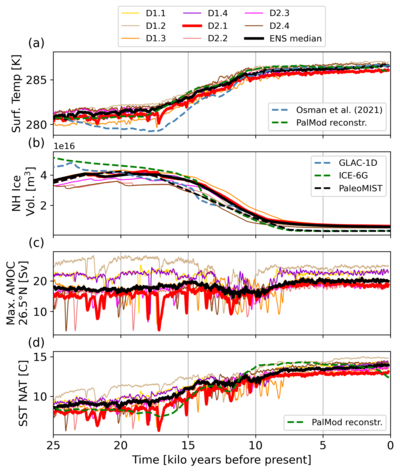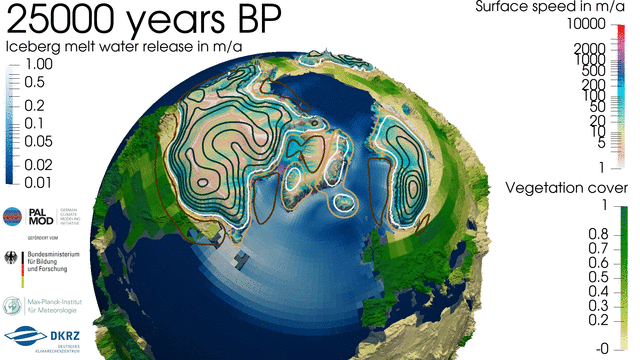New climate model reveals the triggers of abrupt climatic changes in the past 20,000 years

(a) The global mean near surface air temperature (with two proxy-based estimates).
(b) The simulated northern hemisphere land ice volume (together with 3 reconstructions).
(c) The strength of the Atlantic meridional overturning circulation at 26.5°N.
(d) The sea surface temperature in the North Atlantic (with one proxy-based estimate).
20,000 years ago, the Earth’s surface was about four to seven degrees colder than today. Massive ice sheets covered Greenland, Antarctica, North America, and Northwest Eurasia. Because ice sheets store large amounts of water, sea level was 80–100 meters lower than at present. The transition from this time period to the recent climate—triggered by changes in the orbital configuration and by an increase in atmospheric greenhouse gas concentrations — was not smooth, as evidenced by data from ice cores, sediments, and various other sources. This can be explained in part by the complex interplay between different components of the climate system. However, simulating this climate transition with state-of-the-art climate models while fully resolving this interplay has been an unsolved challenge so far.
Using a novel coupled comprehensive atmosphere-ocean-vegetation-ice sheet-solid earth model, a team led by researchers from the Max Planck Institute for Meteorology (MPI-M) performed the first set of simulations of the last deglaciation with a model of such complexity. This model, developed as part of the PalMod project (www.palmod.de), specifically takes into account dynamical changes in the shape and horizontal extent of ice sheets, coastline changes due to sea level variations, changes in river routing, and the production and distribution of icebergs. “We ran an ensemble of eight transient model simulations that realistically captured the key features of the last deglaciation and gave us the opportunity to investigate the drivers of abrupt climate events” says Uwe Mikolajewicz, group leader at MPI-M and lead author of the recently published study.
Iceberg armadas and rivers changing course

The model simulations reveal several cooling events when temperatures dropped rapidly over the North Atlantic and in adjacent regions. Between 20,000 and 13,000 years ago, several of these cooling events were caused by a destabilization of the northern hemisphere ice sheets: According to the simulations, huge armadas of icebergs were released from the North American ice sheet into the Labrador Sea. These icebergs spread over the North Atlantic where they slowly melted. The meltwater lowered the salinity and density of the surface water and prevented the formation of deep water, thereby weakening the Atlantic Meridional Overturning Circulation (AMOC), an ocean current that transports heat from lower to higher latitudes.
Between 13,000 years ago and present-day, when the ice sheet over North America was already much smaller, the researchers identified further mechanisms that can trigger cooling events. “An abrupt weakening of the AMOC can also be induced by changes in the directions of the rivers”, Mikolajewicz points out. Where exactly the meltwater is discharged into the ocean can make a big difference, as it can lead to reduced deep water formation and thus a weakening of the AMOC. In addition, the opening of ocean gateways, such as the Bering Strait or Hudson Strait, can induce abrupt AMOC signals and thereby alter the North Atlantic climate.
The study shows that coupled climate-ice sheet simulations provide an opportunity to investigate the mechanisms behind the abrupt climate changes observed throughout the last deglaciation and emphasizes the need to include the full range of interactions between the atmosphere, the ocean, the land, and the ice sheets. This will improve the physical understanding of the mechanisms behind abrupt climate changes not only in the long-term past but also in the future.
Original publication
Mikolajewicz, U., Kapsch, M.-L., Schannwell, C., Six, K. D., Ziemen, F. A., Bagge, M., Baudouin, J.-P., Erokhina, O., Gayler, V., Klemann, V., Meccia, V. L., Mouchet, A., and Riddick, T.: Deglaciation and abrupt events in a coupled comprehensive atmosphere–ocean–ice-sheet–solid-earth model, Clim. Past, 21, 719–751, https://doi.org/10.5194/cp-21-719-2025, 2025
Contact
Uwe Mikolajewicz
Max Planck Institute for Meteorology
uwe.mikolajewicz@mpimet.mpg.de
Dr. Marie-Luise Kapsch
Max Planck Institute for Meteorology
marie-luise.kapsch@mpimet.mpg.de
Dr. Clemens Schannwell
Max Planck Institute for Meteorology
clemens.schannwell@mpimet.mpg.de
Dr. Katharina Six
Max Planck Institute for Meteorology
katharina.six@mpimet.mpg.de
